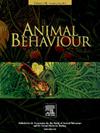Saltatory search in virtual prey does not affect predation risk from fish predators
IF 2.3
2区 生物学
Q2 BEHAVIORAL SCIENCES
引用次数: 0
Abstract
Movement is integral to biological interactions at every scale and, within animal behaviour, links cognition, locomotion and ecological interactions. Saltatory movement is a stop-and-go pattern of motion found across a wide variety of taxa, but little is known about how it affects the vulnerability of moving prey to their predators. Intermittent periods of pause in saltatory movement decrease activity, which has previously been linked to an adaptive reduction in conspicuousness in prey. Accordingly, we predicted that predators would attack constantly moving prey more than prey with saltatory movement. Using a system of three-spined stickleback, Gasterosteus aculeatus, predators attacking simulated virtual prey, we investigated how saltatory movement of prey affects their risk of predation. Computer-generated dots (simulated prey) were programmed to vary in the percentage of time they were stationary (0%, 20%, 40% or 60%). We found no evidence that the fish preferred to attack prey depending on the time the prey spent stationary. Randomization tests revealed that prey speed did not influence the predator's choice of which prey to attack, and that the predator's timing of when to attack was not affected by either the time since the prey's last pause or the duration of that pause. Saltatory search, therefore, appears no more beneficial, or costly, than constant motion in terms of vulnerability to predation. This prompts further questions on the costs and benefits of saltatory motion, how predators perceive intermittent motion, and (more broadly) the relationship between movement and predation risk.
虚拟猎物的跳跃搜索不影响鱼类捕食者的捕食风险
在任何尺度上,运动都是生物相互作用的组成部分,在动物行为中,运动将认知、运动和生态相互作用联系在一起。跳跃式运动是一种走走停停的运动模式,在各种各样的分类群中都有发现,但人们对它如何影响移动猎物对捕食者的脆弱性知之甚少。在跳跃运动中间歇性的停顿会减少活动,这之前被认为与猎物显著性的适应性降低有关。因此,我们预测捕食者会攻击不断移动的猎物,而不是突然移动的猎物。利用三棘棘鱼(Gasterosteus aculeatus)捕食者攻击模拟虚拟猎物的系统,我们研究了猎物的跳跃运动如何影响它们被捕食的风险。计算机生成的点(模拟猎物)被编程为在静止的时间百分比(0%,20%,40%或60%)上变化。我们没有发现证据表明这种鱼会根据猎物静止的时间来攻击猎物。随机试验表明,猎物的速度并不影响捕食者选择攻击哪一个猎物,而且捕食者选择攻击的时机既不受猎物上次暂停的时间的影响,也不受那次暂停的持续时间的影响。因此,从易被捕食的角度来看,跳跃式搜索似乎并不比持续移动更有益或更昂贵。这进一步提出了关于跳跃运动的成本和收益的问题,捕食者如何感知间歇性运动,以及(更广泛地说)运动与捕食风险之间的关系。
本文章由计算机程序翻译,如有差异,请以英文原文为准。
求助全文
约1分钟内获得全文
求助全文
来源期刊

Animal Behaviour
生物-动物学
CiteScore
4.60
自引率
8.00%
发文量
236
审稿时长
10.2 weeks
期刊介绍:
Growing interest in behavioural biology and the international reputation of Animal Behaviour prompted an expansion to monthly publication in 1989. Animal Behaviour continues to be the journal of choice for biologists, ethologists, psychologists, physiologists, and veterinarians with an interest in the subject.
 求助内容:
求助内容: 应助结果提醒方式:
应助结果提醒方式:


